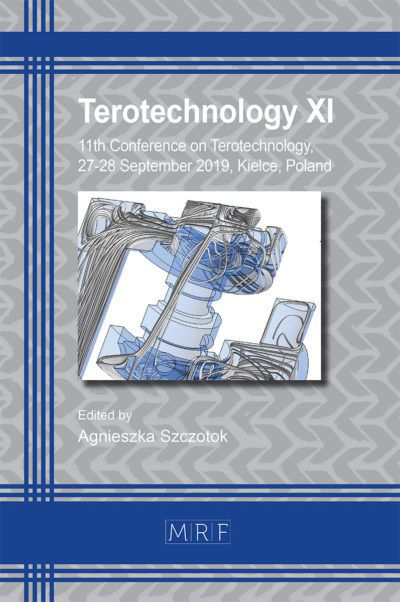–
Experimental, analytical, and numerical analysis of the copper wire multi-pass drawing process
DI DONATO Sara, NEGOZIO Marco, PELACCIA Riccardo, REGGIANI Barbara, DONATI Lorenzo
download PDFAbstract. In the cold wire drawing process, the stress acting on the wire depends on process parameters, as well as on the material flow stress, including the strain-hardening that occurs step by step. It is essential to ensure that the stress applied to the wire at the exit of the die remains below the material’s yield stress, to prevent wire necking and fracture. Industrially, the process is carried out continuously using multi-step-multi-wires machines that deform the material to high strain at elevated strain rate values. The application of analytical models for evaluating the stresses acting on the wire assumes simplified boundary conditions, such as an average distribution of strain and strain rate within the die. Further studies are necessary, considering the entire multi-pass industrial case and involving finite element simulation, which is today the main tool for optimizing industrial processes. In this work, the drawing process applied to ETP Pure Copper (99.9% in weight) is analyzed experimentally, analytically, and numerically. The material was characterized by torsion tests and experimental drawing tests were carried out on four steps of the process. Through the analysis of the different analytical methods, it was shown that a careful evaluation of the friction coefficient values is necessary to reduce errors in estimating the drawing forces. The aim is to provide a reliable numerical model for predicting the stress acting on the wire during the multi-pass drawing process, through an appropriate characterization of the material flow stress and an evaluation of the friction model.
Keywords
Multi-Pass Wire Drawing Process, Copper, Numerical Simulation
Published online 4/24/2024, 11 pages
Copyright © 2024 by the author(s)
Published under license by Materials Research Forum LLC., Millersville PA, USA
Citation: DI DONATO Sara, NEGOZIO Marco, PELACCIA Riccardo, REGGIANI Barbara, DONATI Lorenzo, Experimental, analytical, and numerical analysis of the copper wire multi-pass drawing process, Materials Research Proceedings, Vol. 41, pp 742-752, 2024
DOI: https://doi.org/10.21741/9781644903131-82
The article was published as article 82 of the book Material Forming
![]() Content from this work may be used under the terms of the Creative Commons Attribution 3.0 license. Any further distribution of this work must maintain attribution to the author(s) and the title of the work, journal citation and DOI.
Content from this work may be used under the terms of the Creative Commons Attribution 3.0 license. Any further distribution of this work must maintain attribution to the author(s) and the title of the work, journal citation and DOI.
References
[1] G.E. Dieter, S.L. Semiatin, H.A. Kuhn, Handbook of Workability and Process Design, ASM International publications, United States of America 2003.
[2] K. Lange, Fundamentals of technical plasticity theory, in: Handbook of Metal Forming, first ed., Kurt Lange, Society of Manufacturing Engineers, 1985, pp: 99-132.
[3] J.G. Wistreich, The fundamentals of wire drawing, Metall Rev 3(10) (1958) 97-142.
[4] R. N. Wright, Basic Drawing Mechanics, in: Wire Technology-Process engineering and metallurgy, second ed., Butterworth-Heinemann, 2016, pp: 28-42.
[5] B. Avitzur, C. Narayan, Y.T. Chou, Upper-bound solutions for flow through conical converging dies, International Journal of Machine Tool Design and Research 22(3) (1982) 197-214.
[6] L. Donati, B. Reggiani, R. Pelaccia, M. Negozio and S. Di Donato, Advancements in extrusion and drawing: a review of the contributes by the ESAFORM community, International Journal of Material 15, 41 (2022). https://doi.org/10.1007/s12289-022-01664-w
[7] G. Vega, A. Haddi, A. Imad, Investigation of process parameters effect on the copper-wiredrawing, Materials & Design 30(8) (2009) 3308-3312. https://doi.org/10.1016/j.matdes.2008.12.006
[8] O. Rodríguez-Alabanda, E. Molero, M. Tintelecan, G. Guerrero-Vaca, PE. Romero, GA. Santana Martinez, Fine Electrolytic Tough Pitch Copper Multistage Wiredrawing Pass Schedule Design by Analytical and Numerical Methods, Proceedings. (2020); 63(1):12. https://doi.org/10.3390/proceedings2020063012
[9] L. Lazzarotto, L. Dubar, A. Dubois, P. Ravassard, J. Oudin, Identification of Coulomb’s friction coefficient in real contact conditions applied to a wire drawing process, Wear 211(1) (1997) 54-63. https://doi.org/10.1016/S0043-1648(97)00080-X
[10] K.K. Tang, Z.X. Li, J. Wang, Numerical simulation of damage evolution in multi-pass wire drawing process and its applications, Materials & Design, 32, 6, (2011) 3299-3311, https://doi.org/10.1016/j.matdes.2011.02.026
[11] A. Panteghini, F. Genna, Effects of the strain-hardening law in the numerical simulation of wire drawing processes, Computational Materials Science, 49, 2, (2010), 236-242, https://doi.org/10.1016/j.commatsci.2010.05.002
[12] H. M. Baek, Y. G. Jin, S. K. Hwang, Y. T. Im, I. H. Son, D. L. Lee, Numerical study on the evolution of surface defects in wire drawing, Journal of Materials Processing Technology, 212, 4, (2012), 776-785, https://doi.org/10.1016/j.jmatprotec.2011.10.028
[13] G.R. Canova, U.F. Kocks, J.J. Jonas, Theory of torsion texture development, Acta metall., 32,2 (1984) 211-226. https://doi.org/10.1016/0001-6160(84)90050-6
[14] A. Gräber, K. Pöhlandt, State of the art of the torsion test for determining flow curves, Steel Res., 61 (1990) 212–218.
[15] S. Di Donato, L. Donati, M. Negozio, Copper Wire Multi-Pass Drawing: Process Modeling and Optimization, KEM 926 (2022) 499–510. https://doi.org/10.4028/p-g4wbpz
[16] D.S. Fields, W.A. Backofen, Determination of strain-hardening characteristics by torsion testing, Proc. Am. Soc. Test. Mater. 57 (1957) 1259-1272.
[17] M. El Mehtedi, S. Spigarelli, F. Gabrielli, L. Donati, Comparison Study of Constitutive Models in Predicting the Hot Deformation Behavior of AA6060 and AA6063 Aluminium Alloys, Materials Today: Proceedings, part A 2,10, (2015) 4732-4739. https://doi.org/10.1016/j.matpr.2015.10.006
[18] S. Di Donato, R. Pelaccia, M. Negozio, M. El Mehtedi, B. Reggiani, L. Donati, Hot torsion tests of AA6082 alloy, KEM, under publication.














